Volkssturm
The Volkssturm (German pronunciation: [ˈfɔlks.ʃtʊɐ̯m], "people's storm")[1][2] was a national militia established by Nazi Germany during the last months of World War II. It was not set up by the German Army, the ground component of the combined German Wehrmacht armed forces, but by the Nazi Party on the orders of Adolf Hitler and established on 25 September 1944.[3] It was staffed by conscripting males between the ages of 16 and 60 years, who were not already serving in some military unit. The Volkssturm comprised one of the final components of the total war promulgated by Propaganda Minister Joseph Goebbels, part of a Nazi endeavor to overcome their enemies' military strength through force of will.[4]
| Volkssturm | |
|---|---|
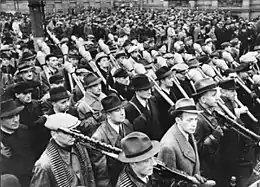 Volkssturm marching, November 1944 | |
| Founded | 18 October 1944 |
| Disbanded | 8 May 1945 |
| Country | |
| Type | Militia |
| Part of | |
| Commanders | |
| Ceremonial chief | Joseph Goebbels |
Origins and organization

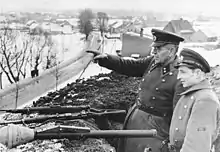
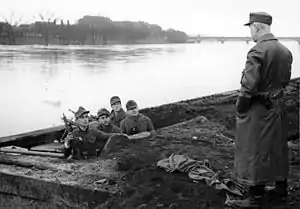
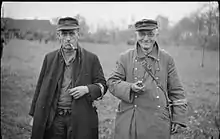
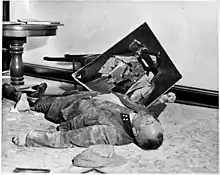
The new Volkssturm drew inspiration from the old Prussian Landsturm of 1813–1815, that fought in the liberation wars against Napoleon, mainly as guerrilla forces.[5] Plans to form a Landsturm national militia in eastern Germany as a last resort to boost fighting strength were first proposed in 1944 by General Heinz Guderian, chief of the General Staff.[6] The Army did not have enough men to resist the Soviet onslaught. So, additional categories of men were called into service, including those in non-essential jobs, those previously deemed unfit, over-age, or under-age, and those recovering from wounds.[7] The Volkssturm had existed, on paper, since around 1925, but it was only after Hitler ordered Martin Bormann to recruit six million men for this militia that the group became a physical reality. While the regime formally established the Volkssturm on 25 September, it was not announced to the public until 16 October 1944.[8] Despite the appeal for this last-ditch effort, the intended strength of "six million" members was never attained.[9][lower-alpha 1]
Joseph Goebbels and other propagandists depicted the Volkssturm as an outburst of enthusiasm and the will to resist.[10] In some regards, the Volkssturm was the culmination of Goebbels' "total war" speech of February 1943 and its formation was "given a big build-up" in the November 1944 newsreel episode of Die Deutsche Wochenschau.[11] Consistent messages of final victory from various Nazi media outlets accompanying the Volkssturm's creation provided a psychological rallying point for the civilian population.[12] While it had some marginal effect on morale, it was undermined by the recruits' visible lack of uniforms and weaponry.[13] Nazi themes of death, transcendence, and commemoration were given full play to encourage the fight.[14] Many German civilians realized that this was a desperate attempt to turn the course of the war. Sardonic old men would remark, "We old monkeys are the Führer’s newest weapon" (in German this rhymes: "Wir alten Affen sind des Führers neue Waffen"). A popular joke about the Volkssturm went "Why is the Volkssturm Germany's most precious resource? Because its members have silver in their hair, gold in their mouths, and lead in their bones."[15]
For these militia units to be effective, they needed not only strength in numbers, but also fanaticism.[16] During the early stages of Volkssturm planning, it became apparent that units lacking morale would lack combat effectiveness. To generate fanaticism, Volkssturm units were placed under direct command of the local Nazi party officials, the Gauleiter and Kreisleiter. The new Volkssturm was also to become a nationwide organization, with Heinrich Himmler, as Replacement Army commander, responsible for armament and training. Though nominally under party control, Volkssturm units were placed under Wehrmacht command when engaged in action. Aware that a "people's army" would not be able to withstand the onslaught of the modern army wielded by the Allies, Hitler issued the following order towards the end of 1944:[17]
Experience in the East has shown that Volkssturm, emergency and reserve units have little fighting value when left to themselves, and can be quickly destroyed. The fighting value of these units, which are for the most part strong in numbers, but weak in the armaments required for modern battle, is immeasurably higher when they go into action with troops of the regular army in the field. I, therefore, order: where Volkssturm, emergency, and reserve units are available, together with regular units, in any battle sector, mixed battle-groups (brigades) will be formed under unified command, so as to give the Volkssturm, emergency, and reserve units stiffening and support.
With the Nazi Party in charge of organizing the Volkssturm, each Gauleiter, or Nazi Party District Leader, was charged with the leadership, enrollment, and organization of the Volkssturm in their district. The largest Volkssturm unit seems to have corresponded to the next smaller territorial subdivision of the Nazi Party organization—the Kreis. The basic unit was a battalion of 642 men. Units were mostly composed of members of the Hitler Youth, invalids, the elderly, or men who had previously been considered unfit for military service.[18][lower-alpha 2] On 12 February 1945, the Nazis conscripted German women and girls into the auxiliaries of the Volkssturm.[19] Correspondingly, girls as young as 14 years were trained in the use of small arms, panzerfaust, machine guns, and hand grenades from December 1944 through May 1945.[20]
Municipal organization:
- A Bataillon (battalion) in every Kreis (roughly equivalent to a U.S. county; there were 920 Kreise in Greater Germany)
- A Kompanie (company) in every Ortsgruppe (the "local chapter" of the Nazi Party).
- A Zug (platoon) in every Zelle (literally a "cell" of Party members; roughly equivalent to a U.S. precinct)
- A Gruppe (squad) in every Block (city block)
Each Gauleiter and Kreisleiter had a Volkssturm Chief of Staff.
From the militia's inception until the spring of 1945, Himmler and Bormann engaged in a power-struggle over the jurisdictional control over the Volkssturm regarding security and police powers in Germany and the occupied territories; a contest which Himmler and his SS more or less won on one level (police and security), but lost to Bormann on another (mobilizing reserve forces).[21] Historian David Yelton described the situation as two ranking officers at the helm of a sinking ship fighting over command.[22]
Benito Mussolini suggested, through his son Vittorio, then general secretary of the Republican Fascist party's German branch, that 30,000 Italians should be added to the Volkssturm in defense of Germany. However, no evidence exists that this offer was implemented.[23]
Uniforms and insignia

The Volkssturm "uniform" was only a black armband with the German words Deutscher Volkssturm Wehrmacht ("German People's Storm Armed Forces").[24] The German government tried to issue as many of its members as possible with military uniforms of all sorts, ranging from Feldgrau to camouflage types. A telling example of the Volkssturm's piecemeal outfitting occurred in the Rhineland, where one unit was provided with "pre-war black SS uniforms, brown Organization Todt coats, blue Air Force auxiliary caps, and French steel helmets."[25] Most members of the Volkssturm, especially elderly members, had no uniform and were not supplied, so they generally wore either work uniforms (including railway workers, policemen and firemen) or their civilian clothing and usually carried with them their own personal rucksacks, blankets, cooking-equipment, etc.[26]
Ranks
The simple paramilitary insignia of the Volkssturm were as follows:
| Volkssturm Rank | Translation | Comparative military rank | Insignia |
|---|---|---|---|
| Bataillonsführer | Battalion leader | Major |  |
| Bataillonsarzt | Battalion Physician | Captain |  with Rod of Asclepius |
| Kompanieführer | Company leader | Captain |  |
| Zugführer | Platoon leader | Lieutenant |  |
| Sanitätsdienstgrad | [Platoon] Medical Orderly |
Corporal |  |
| Gruppenführer | Squad leader | Corporal |  |
| Volkssturmmann | People's Storm Man | Private |
Training and impact


Typically, members of the Volkssturm received only very basic military training. It included a brief indoctrination and training on the use of basic weapons such as the Karabiner 98k rifle and Panzerfaust. Because of continuous fighting and weapon shortages, weapon training was often minimal. There was also a lack of instructors, meaning that weapons training was sometimes done by World War I veterans drafted into service themselves. Often Volkssturm members were only able to familiarize themselves with their weapons when in actual combat.
There was no standardization of any kind and units were issued only what equipment was available. This was true of every form of equipment—Volkssturm members were required to bring their own uniforms and culinary equipment etc. This resulted in the units looking very ragged and, instead of boosting civilian morale, it often reminded people of Germany's desperate state.[13] Armament was equally haphazard: though some Karabiner 98ks were on hand, members were also issued older Gewehr 98s and 19th-century Gewehr 71s and Steyr-Mannlicher M1888s, as well as Dreyse M1907 pistols. In addition there was a plethora of Soviet, British, Belgian, French, Italian, and other weapons that had been captured by German forces during the war. The Germans had also developed cheap but reasonably effective Volkssturm weapons, such as MP 3008 machine pistols and Volkssturmgewehr rifles. These were completely stamped and machine-pressed constructions (in the 1940s, industrial processes were much cruder than today, so a firearm needed great amounts of semi-artisanal work to be actually reliable). The Volkssturm troops were nominally supplied when and where possible by both the Wehrmacht and the SS.[27] By the end of January 1945, the Volkssturm had only accumulated 40,500 rifles and 2,900 machine guns amid this mish-mash of foreign and outdated assemblage of weapons.[28]
When units had completed their training and received armament, members took a customary oath to Hitler and were then dispatched into combat. Teenagers and middle-aged men were sent to separate training camps, some of whom received as little as ten to fourteen days of training before being sent to fight.[29] Unlike most English-speaking countries, Germany had universal military service for all young men for several generations, so many of the older members would have had at least basic military training from when they served in the German Army and many would have been veterans of the First World War. Volkssturm units were supposed to be used only in their own districts, but many were sent directly to the front lines. Ultimately, it was their charge to confront the overwhelming power of the British, Canadian, Soviet, American, and French armies alongside Wehrmacht forces to either turn the tide of the war or set a shining example for future generations of Germans and expunge the defeat of 1918 by fighting to the last, dying before surrendering.[30][lower-alpha 3] It was an apocalyptic goal which some of those assigned to the Volkssturm took to heart. Unremittingly fanatical members of the Volkssturm refused to abandon the Nazi ethos unto the dying days of Nazi Germany, and in a number of instances took brutal "police actions" against German civilians deemed defeatists or cowards.[31]
On some occasions, members of the Volkssturm showed tremendous courage and a determined will to resist, more so even than soldiers in the Wehrmacht. The Volkssturm battalion 25/235 for instance, started out with 400 men but fought on until there were only 10 men remaining. Fighting at Küstrin between 30 January to 29 March 1945, militia units made up mostly of the Volkssturm resisted for nearly two months. Losses were upwards of 60 percent for the Volkssturm at Kolberg, roughly 1900 of them died at Breslau, and during the Battle of Königsberg (Kaliningrad), another 2400 members of the Volkssturm were killed.[32] At other times along the western front particularly, Volkssturm troops would cast their arms aside and disappear into the chaos.[8] Youthful ardor and fanaticism among Hitler Youth members fighting with the Volkssturm or an insatiable sense of duty from old men proved tragic sometimes. An example shared by historian Stephen Fritz is instructive in this case:[33]
In one representative village just north of Bad Windsheim, the Herbolzheim Volkssturm unit, with its customary composition of elderly men and young boys under the influence of a few regular army soldiers, foolishly declared the town a fortress and laid mines in the streets. As American troops approached in midmorning on April 12, shots from the village rang out. Angered, the Americans commenced a two-hour artillery barrage complemented by aerial attacks that gutted the town with incendiary and high-explosive bombs. With their village engulfed in flames, the civilian inhabitants, mostly the elderly, women, and children, fled in search of shelter to the surrounding fields, all the while under American fire.
Not every Volkssturm unit was suicidal or apocalyptic in outlook as the war drew closer to its end. Many of them lost their enthusiasm for the fight when it became clear that the Allies had won, prompting them to lay down their weapons and surrender – they also feared being captured by Allied forces and tortured or executed as partisans.[34] Duty to their communities and sparing them from horrors like at Bad Windsheim also played a part in their capitulation, as did self-preservation.[35]
Battle for Berlin
Their most extensive use was during the Battle of Berlin, where Volkssturm units fought in many parts of the city. This battle was particularly devastating to its formations, however; many members fought to the death out of fear of being captured by the Soviets, holding out to the very end, which was in keeping with their covenant.[36] The Volkssturm had a strength of about 60,000 in the Berlin area, formed into 92 battalions, of which about 30 battalions of Volkssturm I (those with some weapons) were sent to forward positions, while those of Volkssturm II (those without weapons) remained in the inner city.[37] One of the few substantive fighting units left to defend Berlin was the LVI Panzer Corps, which occupied the southeastern sector of the town, whereas the remaining parts of the city were being defended by what remained of the SS, the Volkssturm, and the Hitler Youth formations.[38] Nonetheless, a force of over 2.5 million Soviet troops, equipped with 6,250 tanks and over 40,000 artillery pieces were assigned to capture the city, and the diminished remnants of the Wehrmacht were no match for them. Meanwhile, Hitler denounced every perceived "betrayal" to the inhabitants of the Führerbunker.[39] Not eager to die what was thought to be a pointless death, many older members of the Volkssturm looked for places to hide from the approaching Soviet Army.[40] Juxtaposed against the tragic image of Berlin holding out against all odds was the frequent exodus and capitulation of Wehrmacht soldiers and members of the Volkssturm in southern and western Germany.[41]
One notable and unusual Volkssturm unit in the Battle for Berlin was the 3/115 Siemensstadt Battalion. It comprised 770 men, mainly First World War veterans in their 50s who were reasonably fit factory workers, with experienced officers. Unlike most Volkssturm units it was quite well equipped and trained. It was formed into three rifle companies, a support company (with two infantry support guns, four infantry mortars and heavy machine guns), and a heavy weapons company (with four Soviet M-20 howitzers and a French De Bange 220 mm mortar). The battalion first engaged Soviet troops at Friedrichsfelde on 21 April and saw the heaviest fighting over the following two days. It held out until 2 May, by which time it was down to just 50 rifles and two light machine guns. The survivors fell back to join other Volkssturm units. 26 men from the battalion were awarded the Iron Cross.[42] Allied bombing and Soviet artillery had reduced Berlin to rubble; meanwhile the final stand in Berlin dwindled to fighting against highly trained, battle-hardened Soviet troops on the brink of final victory, who viewed resistance fighters like the Volkssturm as terrorists in much the same way the Wehrmacht once had viewed potential partisans during Operation Barbarossa.[43] Red Army soldiers called the Hitler Youth formations and members of the Volkssturm still fighting to the end in Berlin "totals" for being part of Germany's total mobilization effort.[44]
Final phase
While Iron Crosses were being handed out in places like Berlin, other cities and towns like Parchim and Mecklenburg witnessed old elites, acting as military commandants over the Hitler Youth and Volkssturm, asserting themselves and demanding that the defensive fighting stop so as to spare lives and property.[45] Despite their efforts, the last four months of the war were an exercise in futility for the Volkssturm, and the Nazi leadership's insistence to continue the fight to the bitter end contributed to an additional 1.23 million (approximated) deaths, half of them German military personnel and the other half from the Volkssturm.[46] The figure put forward by the historian Stephen Fritz does not match the observations of Richard J. Evans, who reported 175,000 Volkssturm members killed when fighting the professional armies of the western Allies and the Soviet Union.[47] Evans' figures are based on the members listed in the index cards and reported as killed, while Martin Sorge pointed out that this figure did not include the 30,000 listed as presumed missing or dead in a 1963 report.[48]
Sometime in early April 1945 as Allied forces approached the Mittelwerk facilities—where V2 rockets were being produced—the slave laborers from the Mittelbau-Dora concentration camp were force-marched from the western Harz by a collection of guards drawn from the military, the Hitler Youth, and the Volkssturm.[49] Approximately 40 kilometers north of Magdeburg in the village of Mieste, this motley assemblage of guards locked a thousand of these prisoners in a barn and burned them alive at the instruction of a local Nazi Party leader.[49] At the town of Celle in Lower Saxony around the same time, members of the SS, SA, local police, Hitler Youth, and Volkssturm were aided by locals to "hunt down and shoot" prisoners who had fled into the local woodland after their transport train was bombed.[50]
Interrogated members of the Volkssturm—when questioned as to where the regular forces had gone—revealed that German soldiers surrendered to the Americans and British instead of the Red Army for fear of reprisals related to the atrocities they had committed in the Soviet Union.[51]
Notable members
- Otto Dix, German painter
- Gerhart Drabsch, German writer, killed on the Eastern Front in 1945
- Martin Heidegger, German philosopher[52]
- Ernst Tiburzy, received the Knight's Cross of the Iron Cross.[53]
- Gustav Anton von Wietersheim, WW1 veteran and WW2 general dismissed for apparent failures early in the Battle of Stalingrad
In fiction
- Gregor Dorfmeister, under the pseudonym of Manfred Gregor, in 1958 published the novel Die Brücke, based on his experiences in a Volkssturm unit. The novel was adapted to film the following year and to a made-for-television movie in 2008.
- Volkssturm units composed of teenagers are depicted in battle scenes in the 2004 film Downfall.[lower-alpha 4]
See also
- Einstossflammenwerfer 46
- Landwehr
- MP 3008
- Volksgrenadier
- Volkspistole
- Volkssturmgewehr
- Wachdienst
- Werwolf Guerrillas
Other nations:
Notes
- Historian Nicholas Stargardt also notes that if every able-bodied German man between the ages of 16 to 60 had been levied, the Volkssturm could have grown to upwards of 13.5 million, which would have exceeded the size of the Wehrmacht.[3]
- Hans Jürgen Massaquoi, who was of Liberian and German parents, had been rejected by the Jungvolk and the Wehrmacht on racial grounds, but was called by the Volkssturm. See: Hans J. Massaquoi, Destined to Witness, 1990.
- Also see: Berd Wegner, "Zweite Weltkrieg und die Choreographie des Untergangs", Geschichte und Gesellschaft, vol. xxvi (2000), no. 3, pp. 492–518.
- See Downfall (2004) on IMDB.com: https://www.imdb.com/title/tt0363163/?___441
References
Citations
- Fritz 2004, p. ix.
- Kershaw 2011, pp. 86–88.
- Stargardt 2015, p. 456.
- Kershaw 2001, pp. 713–714.
- Herzstein 1986, p. 246.
- Guderian 2001, p. 362.
- Moorhouse 2012, p. 351.
- Burleigh 2000, p. 786.
- Read 2005, p. 855.
- Herzstein 1986, pp. 251–252.
- Welch 2002, p. 120.
- Kallis 2005, pp. 181, 192.
- Herzstein 1986, p. 248.
- Herzstein 1986, p. 252.
- Fritz 2004, p. 36.
- Benz 2007, p. 254.
- Trevor-Roper 1964, p. 204.
- Zentner & Bedürftig 1991, pp. 1004–1005.
- Hildebrand 1984, p. 82.
- Kater 2004, p. 238.
- Yelton 2003, pp. 167–177.
- Yelton 2003, p. 176.
- Goeschel 2018, p. 287.
- Lepage 2009, p. 153.
- Stargardt 2015, p. 458.
- Evans 2010, pp. 675–676.
- Duffy 2002, p. 383.
- Stargardt 2015, pp. 456–457.
- Stargardt 2015, p. 457.
- Bessel 2010, p. 17.
- Kershaw 2011, p. 87.
- Sorge 1986, pp. 49–50.
- Fritz 2004, p. 121.
- Moorhouse 2012, p. 352.
- Bessel 2010, p. 22.
- Kissel 1962, p. 32.
- Beevor 2002, p. 178.
- Ziemke 1968, p. 481.
- Bessel 2010, pp. 104–109.
- Kershaw 2001, p. 811.
- Bessel 2010, pp. 135–137.
- Le Tissier 2008, p. 212.
- Beevor 2002, p. 299–301.
- Beevor 2002, p. 316.
- Bessel 2010, pp. 139–140.
- Fritz 2004, p. 191.
- Evans 2010, p. 676.
- Sorge 1986, p. 50.
- Stargardt 2015, p. 516.
- Stargardt 2015, p. 517.
- Beevor 2002, p. 308.
- Safranski 1999, pp. 332–333.
- Fellgiebel 2000, pp. 423, 506.
Bibliography
- Beevor, Antony (2002). The Fall of Berlin, 1945. New York; London: Viking. ISBN 0-670-03041-4.
- Benz, Wolfgang (2007). A Concise History of the Third Reich. Berkeley and Los Angeles: University of California Press. ISBN 978-0-52025-383-4.
- Bessel, Richard (2010). Germany 1945: From War to Peace. New York: Harper Perennial. ISBN 978-0-06054-037-1.
- Burleigh, Michael (2000). The Third Reich: A New History. New York: Hill and Wang. ISBN 978-0-80909-325-0.
- Duffy, Christopher (2002). Red Storm on the Reich: The Soviet March on Germany, 1945. Edison, NJ: Castle Books. ISBN 0-7858-1624-0.
- Evans, Richard (2010). The Third Reich at War. New York: Penguin. ISBN 978-0-14311-671-4.
- Fellgiebel, Walther-Peer (2000). Die Träger des Ritterkreuzes des Eisernen Kreuzes 1939–1945 (in German). Friedberg: Podzun-Pallas. ISBN 978-3-7909-0284-6.
- Fritz, Stephen G. (2004). Endkampf: Soldiers, Civilians, and the Death of the Third Reich. Lexington: The University Press of Kentucky. ISBN 978-0-81312-325-7.
- Goeschel, Christian (2018). Mussolini and Hitler: The Forging of the Fascist Alliance. New Haven and London: Yale University Press. ISBN 0300178832.
- Guderian, Heinz (2001). Panzer Leader. New York and Boston: Da Capo Press. ASIN B008CMU05I.
- Herzstein, Robert E. (1986). The War That Hitler Won: Goebbels and the Nazi Media Campaign. St Paul, MN: Paragon House. ISBN 978-0913729472.
- Hildebrand, Klaus (1984). The Third Reich. London and New York: Routledge. ISBN 0-0494-3033-5.
- Kallis, Aristotle (2005). Nazi Propaganda and the Second World War. New York: Palgrave MacMillan. ISBN 978-0-23054-681-3.
- Kater, Michael H. (2004). Hitler Youth. Cambridge, MA: Harvard University Press. ISBN 0-674-01496-0.
- Kershaw, Ian (2001). Hitler: 1936–1945, Nemesis. New York: W. W. Norton & Company. ISBN 978-0-39332-252-1.
- Kershaw, Ian (2011). The End: The Defiance and Destruction of Hitler’s Germany, 1944–1945. New York: Penguin Books. ISBN 978-0-14312-213-5.
- Kissel, Hans (1962). Der Deutsche Volkssturm 1944/45: Eine territoriale Miliz im Rahmen der Landesverteidung (in German). Frankfurt am Main: Verlag E. S. Mittler und Sohn. ASIN B00DSDZEGQ.
- Lepage, Jean-Denis G.G. (2009). Hitler Youth, 1922–1945: An Illustrated History. Jefferson, NC; London: McFarland & Co. ISBN 978-0-78643-935-5.
- Le Tissier, Tony (2008). Berlin Battlefield Guide: Third Reich & Cold War. South Yorkshire: Pen & Sword Military. ISBN 1-84415-766-0.
- Massaquoi, Hans J. (1990). Destined to Witness: Growing Up Black in Nazi Germany. Chapel Hill: University of North Carolina Press.
- Moorhouse, Roger (2012). Berlin at War. New York: Basic Books. ISBN 978-0-46502-855-9.
- Read, Anthony (2005). The Devil's Disciples: Hitler's Inner Circle. New York: Norton. ISBN 978-039332-697-0.
- Safranski, Rüdiger (1999). Martin Heidegger: Between Good and Evil. Cambridge, MA: Harvard University Press. ISBN 978-0-67438-710-2.
- Sorge, Martin K. (1986). The Other Price of Hitler's War: German Military and Civilian Losses Resulting from World War II. New York: Greenwood Press. ISBN 978-0-31325-293-8.
- Stargardt, Nicholas (2015). The German War: A Nation Under Arms, 1939–1945. New York: Basic Books. ISBN 978-0-46501-899-4.
- Trevor-Roper, Hugh (1964). Blitzkrieg to Defeat: Hitler's War Directives, 1939–1945. New York: Holt, Rinehart and Winston. ISBN 978-0-03085-494-1.
- Welch, David (2002). The Third Reich: Politics and Propaganda. New York: Routledge. ISBN 978-0-41511-910-8.
- Yelton, David K. (2003). "The SS, NSDAP, and the Question of Volkssturm Expansion". In Alan E. Steinweis; Daniel Rogers (eds.). The Impact of Nazism: New Perspectives on the Third Reich and Its Legacy. Lincoln, NE: University of Nebraska Press. ISBN 978-0-80324-299-9.
- Zentner, Christian; Bedürftig, Friedemann (1991). The Encyclopedia of the Third Reich (2 vols.). New York: MacMillan Publishing. ISBN 0-02-897500-6.
- Ziemke, Earl F (1968). Stalingrad to Berlin: The German Defeat in the East. Washington D.C.: Office of the Chief of Military History – U.S. Army. ASIN B002E5VBSE.
External links
| Wikimedia Commons has media related to Volkssturm. |